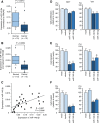Aberrantly expressed PLOD1 promotes cancer aggressiveness in bladder cancer: a potential prognostic marker and therapeutic target
- PMID: 31199049
- PMCID: PMC6717764
- DOI: 10.1002/1878-0261.12532
Aberrantly expressed PLOD1 promotes cancer aggressiveness in bladder cancer: a potential prognostic marker and therapeutic target
Abstract
Bladder cancer (BC) is the ninth most malignant tumor worldwide. Some BC patients will develop muscle-invasive BC (MIBC), which has a 5-year survival rate of approximately 60% due to metastasis. As such, there is an urgent need for novel therapeutic and diagnostic targets for MIBC. Analysis of novel antitumor microRNA (miRNA)-mediated cancer networks is an effective strategy for exploring therapeutic targets and prognostic markers in cancers. Our previous miRNA analysis revealed that miR-140-5p acts as an antitumor miRNA in BC cells. Here, we investigated miR-140-5p regulation of BC molecular pathogenesis. Procollagen-lysine, 2-oxoglutarate 5-dioxygenase 1 (PLOD1) was found to be directly regulated by miR-140-5p, and aberrant expression of PLOD1 was observed in BC clinical specimens. High PLOD1 expression was significantly associated with a poor prognosis (disease-free survival: P = 0.0204; overall survival: P = 0.000174). Multivariate analysis showed PLOD1 expression to be an independent prognostic factor in BC patients (hazard ratio = 1.51, P = 0.0099). Furthermore, downregulation of PLOD1 by siRNAs and a specific inhibitor significantly decreased BC cell aggressiveness. Aberrant expression of PLOD1 was closely associated with BC pathogenesis. In summary, the present study showed that PLOD1 may be a potential prognostic marker and therapeutic target for BC.
Keywords: miR-140-5p; PLOD1; bladder cancer; inhibitor; microRNA; passenger strand.
© 2019 The Authors. Published by FEBS Press and John Wiley & Sons Ltd.
Conflict of interest statement
The authors declare no conflict of interest.
Figures




Similar articles
-
Dual strands of the miR-223 duplex (miR-223-5p and miR-223-3p) inhibit cancer cell aggressiveness: targeted genes are involved in bladder cancer pathogenesis.J Hum Genet. 2018 May;63(5):657-668. doi: 10.1038/s10038-018-0437-8. Epub 2018 Mar 14. J Hum Genet. 2018. PMID: 29540855
-
Regulation of UHRF1 by dual-strand tumor-suppressor microRNA-145 (miR-145-5p and miR-145-3p): Inhibition of bladder cancer cell aggressiveness.Oncotarget. 2016 May 10;7(19):28460-87. doi: 10.18632/oncotarget.8668. Oncotarget. 2016. PMID: 27072587 Free PMC article.
-
Tumour-suppressive miRNA-26a-5p and miR-26b-5p inhibit cell aggressiveness by regulating PLOD2 in bladder cancer.Br J Cancer. 2016 Jul 26;115(3):354-63. doi: 10.1038/bjc.2016.179. Epub 2016 Jun 16. Br J Cancer. 2016. PMID: 27310702 Free PMC article.
-
The role of microRNAs in bladder cancer.Investig Clin Urol. 2016 Jun;57 Suppl 1(Suppl 1):S60-76. doi: 10.4111/icu.2016.57.S1.S60. Epub 2016 Jun 7. Investig Clin Urol. 2016. PMID: 27326409 Free PMC article. Review.
-
microRNA expression profiles as decision-making biomarkers in the management of bladder cancer.Histol Histopathol. 2017 Feb;32(2):107-119. doi: 10.14670/HH-11-814. Epub 2016 Sep 2. Histol Histopathol. 2017. PMID: 27586262 Review.
Cited by
-
The relationship between PLOD1 expression level and glioma prognosis investigated using public databases.PeerJ. 2021 May 14;9:e11422. doi: 10.7717/peerj.11422. eCollection 2021. PeerJ. 2021. PMID: 34040895 Free PMC article.
-
Identification and Quantification of Iron Metabolism Landscape on Therapy and Prognosis in Bladder Cancer.Front Cell Dev Biol. 2022 Feb 21;10:810272. doi: 10.3389/fcell.2022.810272. eCollection 2022. Front Cell Dev Biol. 2022. PMID: 35265613 Free PMC article.
-
The effect of a novel glycolysis-related gene signature on progression, prognosis and immune microenvironment of renal cell carcinoma.BMC Cancer. 2020 Dec 7;20(1):1207. doi: 10.1186/s12885-020-07702-7. BMC Cancer. 2020. PMID: 33287763 Free PMC article.
-
Classification of Muscle Invasive Bladder Cancer to Predict Prognosis of Patients Treated with Immunotherapy.J Immunol Res. 2022 May 30;2022:6737241. doi: 10.1155/2022/6737241. eCollection 2022. J Immunol Res. 2022. PMID: 35677536 Free PMC article.
-
PLOD1 Is a Prognostic Biomarker and Mediator of Proliferation and Invasion in Osteosarcoma.Biomed Res Int. 2020 Oct 19;2020:3418398. doi: 10.1155/2020/3418398. eCollection 2020. Biomed Res Int. 2020. PMID: 33134376 Free PMC article.
References
-
- Anaya J (2016) OncoLnc: linking TCGA survival data to mRNAs, miRNAs, and lncRNAs. PeerJ Comput Sci 2, e67.
-
- Antoni S, Ferlay J, Soerjomataram I, Znaor A, Jemal A and Bray F (2017) Bladder cancer incidence and mortality: a global overview and recent trends. Eur Urol 71, 96–108. - PubMed
Publication types
MeSH terms
Substances
LinkOut - more resources
Full Text Sources
Medical
Molecular Biology Databases
Research Materials
Miscellaneous

